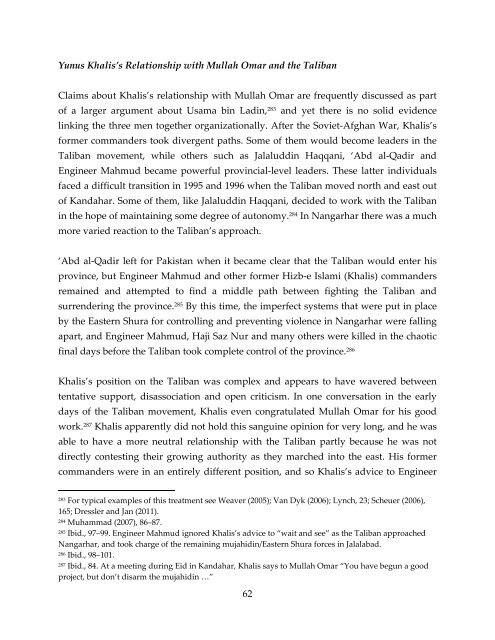Usama bin Ladin’s “Father Sheikh”:
Usama bin Ladin’s “Father Sheikh”:
Usama bin Ladin’s “Father Sheikh”:
You also want an ePaper? Increase the reach of your titles
YUMPU automatically turns print PDFs into web optimized ePapers that Google loves.
Yunus Khalis’s Relationship with Mullah Omar and the Taliban<br />
Claims about Khalis’s relationship with Mullah Omar are frequently discussed as part<br />
of a larger argument about <strong>Usama</strong> <strong>bin</strong> Ladin, 283 and yet there is no solid evidence<br />
linking the three men together organizationally. After the Soviet‐Afghan War, Khalis’s<br />
former commanders took divergent paths. Some of them would become leaders in the<br />
Taliban movement, while others such as Jalaluddin Haqqani, ‘Abd al‐Qadir and<br />
Engineer Mahmud became powerful provincial‐level leaders. These latter individuals<br />
faced a difficult transition in 1995 and 1996 when the Taliban moved north and east out<br />
of Kandahar. Some of them, like Jalaluddin Haqqani, decided to work with the Taliban<br />
in the hope of maintaining some degree of autonomy. 284 In Nangarhar there was a much<br />
more varied reaction to the Taliban’s approach.<br />
‘Abd al‐Qadir left for Pakistan when it became clear that the Taliban would enter his<br />
province, but Engineer Mahmud and other former Hizb‐e Islami (Khalis) commanders<br />
remained and attempted to find a middle path between fighting the Taliban and<br />
surrendering the province. 285 By this time, the imperfect systems that were put in place<br />
by the Eastern Shura for controlling and preventing violence in Nangarhar were falling<br />
apart, and Engineer Mahmud, Haji Saz Nur and many others were killed in the chaotic<br />
final days before the Taliban took complete control of the province. 286<br />
Khalis’s position on the Taliban was complex and appears to have wavered between<br />
tentative support, disassociation and open criticism. In one conversation in the early<br />
days of the Taliban movement, Khalis even congratulated Mullah Omar for his good<br />
work. 287 Khalis apparently did not hold this sanguine opinion for very long, and he was<br />
able to have a more neutral relationship with the Taliban partly because he was not<br />
directly contesting their growing authority as they marched into the east. His former<br />
commanders were in an entirely different position, and so Khalis’s advice to Engineer<br />
283 For typical examples of this treatment see Weaver (2005); Van Dyk (2006); Lynch, 23; Scheuer (2006),<br />
165; Dressler and Jan (2011).<br />
284 Muhammad (2007), 86–87.<br />
285 Ibid., 97–99. Engineer Mahmud ignored Khalis’s advice to “wait and see” as the Taliban approached<br />
Nangarhar, and took charge of the remaining mujahidin/Eastern Shura forces in Jalalabad.<br />
286 Ibid., 98–101.<br />
287 Ibid., 84. At a meeting during Eid in Kandahar, Khalis says to Mullah Omar “You have begun a good<br />
project, but don’t disarm the mujahidin …”<br />
62


